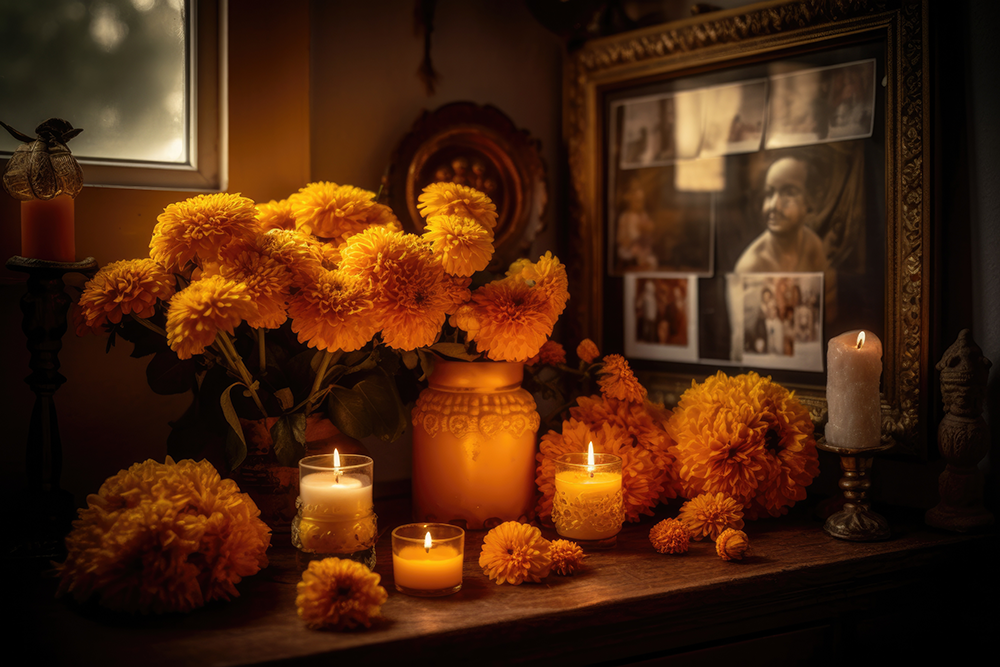October has always been one of my favorite times of the year. I allow fall to remind me that things come to an end and that they can still be beautiful. I always think of the quote, “The leaves are about to show us how beautiful it can be to let the dead go.” It also helps that Halloween is my favorite holiday. As the excitement of Halloween has come to a close this year, I can’t help but think of another holiday our neighbors to the South have just celebrated.
In the United States, we typically mourn loved ones, when they die, with a funeral service. These services are specific to religious and cultural beliefs, but, usually, at these services, it is a sad time and signified with dark, solemn clothing where we say goodbye. As an End of Life Doula, I would argue that one of the reasons “saying goodbye” to a loved one is such a solemn event is because we have such an unhealthy relationship with death. Death in the United States is seen as so taboo. We don’t like to talk about it, we don’t like to think about it, so we rarely plan for it. It creates a relationship where we are afraid of facing our own mortality. As an End-of-Life Doula, I love to explore the way that one culture has created a way to recognize and accept death as a part of life, so the way they honor deceased loved ones is with an annual celebration.
Dia de Los Muertos, or Day of the Dead, begins at midnight on November 1st and is celebrated through November 2nd. It is a two-day celebration where it is believed that the passageway between the real world and the spirit world is open, so deceased loved ones can come back to visit. Traditional items that are utilized for the Day of the Dead: altars or Ofrendas, where favorite foods, drinks, and other items of loved ones are placed; marigolds that are believed to create a pathway for deceased loved ones; skulls, which are often also placed on the Ofrendas; La Catrina, where you see individuals paint their faces as skulls; and Papel Picado, which are chiseled spirit figures on wood that are also placed on Ofrendas.
One of my goals as an End-of-Life Doula is to talk about and educate on different topics related to death so we, in the United States, can begin to create a healthier relationship with death. In creating a healthier relationship with death, we may be able to create a healthier outlook on getting older and how we treat our elderly. It is a difficult journey, and I am constantly battling societal norms that individuals have been accustomed to their whole lives. So, when I see death positivity in everyday life, I love it.
My almost two-year-old daughter has recently taken an interest in Disney’s Coco. By taking an interest, I mean we watch it two to three times a day. While watching the same movie almost 14 times in a week can cause some parents to question their sanity, I never hesitate to put it on for her. I think the messages within the story are that important. If you have not seen the movie Coco, I highly recommend it. Coco is extremely death-positive and challenges many taboo ideas for those of us from the US.
Coco follows a young boy, Miguel, and his journey during the Day of the Dead as he learns the importance of family—young, old, and deceased. We first meet Miguel as he explains his family line to us. We also see his relationships within a multi-generational family living together. It was especially special for me to watch the relationship Disney created between Miguel and his great-grandmother, Mama Coco. As he introduces her, he states, “Mama Coco has trouble remembering things, but it’s good to talk to her anyway, so I tell her pretty much everything.” Miguel travels to the spirit world seeking out his great-great-grandfather’s approval as a musician. He learns the significance of honoring and remembering his ancestors. We also get a little snippet where they address the effect that music can have on someone, especially on someone with dementia.
Coco is such a beautiful representation of having a healthy relationship with death and how that can benefit our lives overall. Understanding death is a part of life reminds us to appreciate the little things about everyday life—like getting to watch Coco with my two-year-old. I encourage everyone to add that to their movie lineup for this year.


